
|
|

I
took over this e-zine when Gail, its originator was unable to continue it. With
Gail's permission, I have added her original Rock's of the Week so that everyone
can find the information readily. Please feel free to visit Gail's web site at http://www.davesrockshop.com. |
|
Malachite
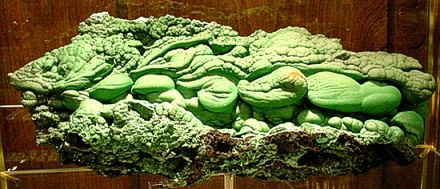
|
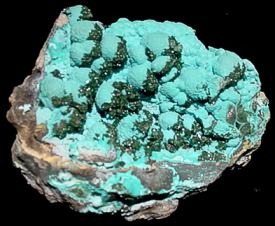
|
|
Scientific:
Malachite is a secondary ore that occurs in the upper levels of copper deposits. The hydrothermal action of atmospheric agents on copper mineral outcrops has combined copper with solutions of carbonated water to produce malachite. It is the copper content of malachite that gives it a green (like tarnish) color. More water in the copper makes it lighter and less water makes it darker. The absence of water makes it black.
Crystals are rare, mostly dense, fibrous fine-crystalline aggregates. Malachite sometimes occurs in rounded
(mamillated) nodules, botryoidal shapes, grape shapes, cone shapes, or stalactite and, rarely, encrusted slabs. |
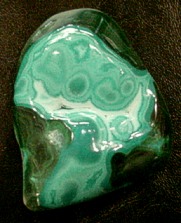
|
|
Malachite forms relatively quickly. Bronze objects have been found at ancient Assyrian sites partially or wholly converted into malachite. Grains of sand bound together by malachite particles are a further indicator that it forms quickly. This formation is known as "Wheal Leisure."
In fractures or when cut, malachite shows a banding of light and dark green with concentric rings, straight stripes, or oilier figurative shapes caused by its shell-like formation. The stratifications are curved (transverse to the length of the crystal), which are obviously successive layers of concretion, according to the outer surface of the mass.
|
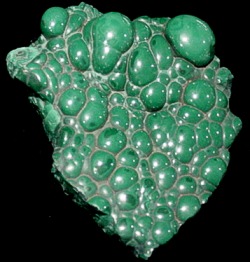
|
As rough stone, it has a weak vitreous or mat luster; on fresh fractures and when polished, it has a silky luster.
The cutter must work the malachite so as to show the decorative marking to its best advantage. Concentric eye-like rings are called malachite peacock's eye and are the most popular. Large mono-colored pieces are rare.
In thin plates it is translucent otherwise it is opaque.
Today Shaba (Katanga) in Zaire is the most important malachite producer. Other deposits are in Zambia, Namibia, Zimbabwe, Australia (Queensland, New
South Wales), Chile, France and Arizona and New Mexico in the USA. It is found almost everywhere in the form of small encrustations, together with azurite. |
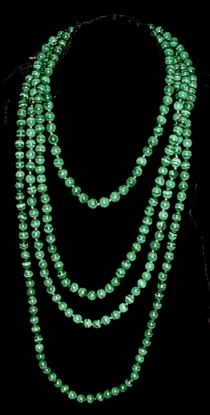
|
|
The name is probably derived from the green color
(Greek-malache = mallow), or perhaps from its low hardness
(Greek-malakos = soft). It is not often used as a gem and has a very low value in relation to precious and semi-precious stones. It is much admired, however, as an ornamental material and is quite highly priced for this category, especially when the attractiveness of the material is matched by fine workmanship.
Because of its low hardness, malachite is easily scratched and sometimes becomes dull. The surface can be hardened with artificial resin. Malachite is sensitive to heat, acids, ammonia, and hot waters.
Hardness: 3.5 - 4
Chemical Composition: Cu2CO3(OH)2 |
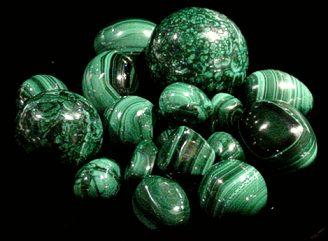
|
|
History:
Malachite was popular with the ancient Egyptians, Greeks, and Romans for jewelry and amulets. It was also ground along with galena on slate palates. This powder mixed with water was painted on the eyelids. Malachite was being mined in the Sinai Peninsula in 4,000 BC.
The most important deposits used to be in the Urals near Yekaterinburg
(Sverdlovsk). The quarries delivered blocks of over 20 tons in weight. From there, the Russian tsars obtained the malachite for decorating their palaces; paneling the walls and for beautiful inlaid works of art. |
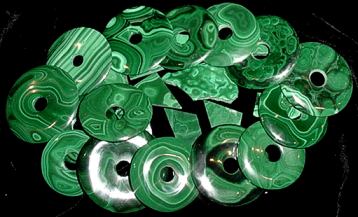
|
Lore:
Italians wear malachite to protect them from the evil eye.
Malachite was considered to be a talisman particularly appropriate for children. If a piece of this stone were attached to an infant's cradle, all evil spirits were held at bay and the child slept soundly and peacefully.
In some parts of Germany, malachite shared with turquoise the repute of protecting the wearer from danger in falling, and it also gave warning of approaching disaster by breaking into several pieces.
The appropriate design to be engraved upon malachite was the image of the sun. Used as a talisman to protect the wearer from enchantments, from evil spirits, and from the attacks of venomous creatures. The sun was regarded as the deadly enemy of all creatures from the "Dark side." |
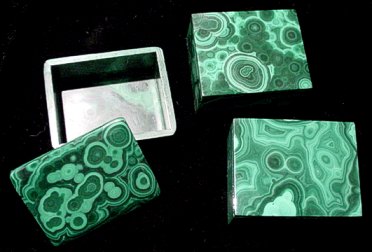
|
|
Health:
Malachite has a long history of health lore. (Because malachite has copper in it, which is toxic, I don't recommend ingesting or inhaling it at all.)
Malachite has been used to ward off danger and fight illness. It has been said to protect against falls, help with tissue regeneration and healing bruised and fractured bones. Try wrapping it in place. Malachite draws the energy of disharmony into and through its own energy vibration. It takes the pain into itself.
Holding a "Peacock's eye" in malachite over a physical area can alter the patterning and isolate and draw out pain. Light and dark green colors representing the earth give strength to face and conquer the pain. If it has been used a lot, place malachite on a clear quartz cluster to recharge it.
It has been said to be particularly beneficial to the eyesight. It was thought that by looking at malachite for a few minutes every day it would increase the oxygen flow to the retina and stimulate the optic nerve. The paste form smeared on the eyelids was thought to cure cataracts.
It has been used in elixir form to treat the teeth. |
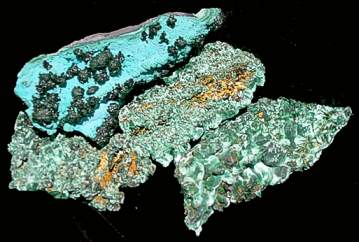
|
Myth:
The hippo goddess Toeris wears a necklace of many beads including malachite. Malachite was admired by ancient followers of the Goddess Venus and thought to possess great powers.
In Rome it was called "Peacock stone," dedicated to the Goddess Juno, who protects against lightning and other perils of nature. |
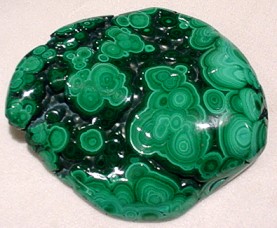
|
Metaphysical:
The essence of malachite is joy. Malachite amplifies the wearer's mood, whether positive or negative. It is said to help dredge up buried emotional pain and release it. This is wonderful for healing work, as well as work with chakras. Malachite can be used with the 4th chakra, and can be used to balance and heal all chakras.
A great formula for remembering past events or emotional trauma is:
Place malachite at the solar plexus, jade at heart and quartz crystal between. The swirls in the malachite are said to accelerate the clockwise spinning of the chakras. This positive effect will open blocked channels and release memories.
Malachite represents fidelity in love and friendship, loyalty in partnerships, and practicality and responsibility in business transactions. As jewelry it is said to help the wearer get in touch with their emotions. (It should be taken off on those over emotional days.) Besides self-knowledge, it can reflect the feelings of the wearer to others. It is said to calm and warm a cold heart, promote emotional maturity and positive transformation and healing. Malachite can be helpful in seeing why you allow others to use your creative power. |

|
Malachite is said to produce purification and healing dreams and draw out the negative energy from nightmares. It also is said to unlock dream memory and understanding thus clarifying the information and making it available for solving everyday problems.
To dream of malachite in any form signifies sweeping changes in your life. Keep your eyes on your goal, and those changes will be for your betterment.
Malachite is said to be the stone of "Great fortune and wealth." It can help direct personal power in a beneficial way. It helps us to connect ourselves to the Earth's energy. This alignment with Earth's power can open the door to more abundance.
It can make what one desires, more achievable. Thought creates reality and energy follows thought. Start a malachite chain by giving a piece of malachite to someone and ask that they do the same. It can augment wealth and spread good fortune globally. |
|














